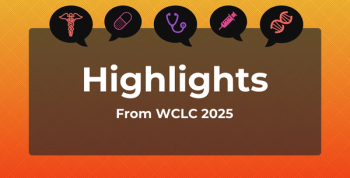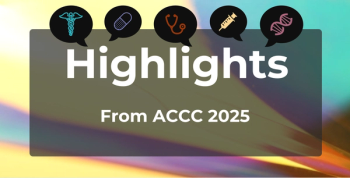
- November 2025
- Volume 31
- Issue 12
- Pages: SP862
Bridging the Gap Between Cutting-Edge Cancer Care and Equitable Access
Key Takeaways
- Precision medicine in NSCLC has improved outcomes, but barriers to biomarker testing and payer coverage delays persist.
- Rapid response protocols in acute leukemia prioritize immediate medical needs over administrative hurdles, ensuring timely treatment.
Experts discuss the urgent need for equitable access to cancer care, addressing barriers in treatment delivery and the importance of personalized medicine.
Although innovations in cancer care are rapidly emerging, systemic and social barriers continue to challenge the delivery of optimal care. The intersection of cutting-edge oncology treatment with equitable access to care was the focus of discussions at an Institute for Value-Based Medicine® regional event held in Houston, Texas, on September 18.
Fostering Equitable Access to Cancer Care in the Era of Precision Medicine
The event began with a focused discussion on non–small cell lung cancer (NSCLC), an area where precision medicine has led to dramatic improvements in outcomes. Anne Tsao, MD, thoracic section chief in the Department of Thoracic/Head and Neck Medical Oncology at The University of Texas MD Anderson Cancer Center (MD Anderson), moderated the panel, which began with a discussion of practical barriers to biomarker testing.
“The logistics of being able to do molecular testing is so important,” Eric Singhi, MD, assistant professor in the Department of General Oncology, Division of Cancer Medicine and the Department of Thoracic/Head and Neck Medical Oncology at MD Anderson, said. “We’ve seen over the last 10 or 20 years that we’ve truly tried to personalize our treatments for patients with lung cancer, and the only way to be able to do that is to make sure we understand their biomarker status, to make sure that we can…figure out how to deliver…personalized medicine that hopefully gives them efficacy and then also tolerability with what we’re trying to prescribe.”
Different molecular tests are crucial for this process, Singhi explained, and comprehensive tissue molecular testing is ideal. However, many providers still prescribe treatment to patients without these tests due to various barriers that must be overcome, he said.
Another issue is the optimal duration of immunotherapy, noted Yasir Elamin, MD, assistant professor in the Department of Thoracic/Head and Neck Medical Oncology at MD Anderson. Several trials are exploring this question and suggest optimal durations, but there is no definitive answer yet.
Repeat genomic testing is another area where questions remain about ideal use, Tsao noted.
“I think this is very much a space where, every year, things are changing,” Natalie Vokes, MD, assistant professor in the Department of Thoracic/Head and Neck Medical Oncology at MD Anderson, explained. “The technologies are changing, the treatment contexts are changing, and the result is that the application of this technology to our treatment space is going to be moving as our tests are changing and the sensitivity of the tests [is] changing.”
Another evolving area is the NSCLC treatment landscape, with Vokes noting that today’s ideal regimen may be replaced with another in a few years. One question is which patients are best suited for adjuvant therapy, given the lack of head-to-head data, she said.
The panel agreed that delays due to payer coverage, infrastructure limitations, and slow turnaround times for tissue biopsies impede the ability to match patients with the optimal targeted therapy or immunotherapy. To initiate care in a timely manner, early multidisciplinary care for patients with early-stage disease is an important step, Singhi said.
Elamin brought the conversation back to the central pillar of the discussion: equity.
“We need to make sure that all our patients have equal access to molecular testing,” Elamin said. “Every patient should undergo molecular testing; every patient should have equal access to clinical trials. Clinical research saves lives, so I think all our practice should be geared toward that goal.”
Rethinking Therapy, Access, and Value in Malignant Hematology
Shifting from solid tumors to malignant hematology, the next panel focused on the urgency of diagnosis, the financial challenges of novel therapies, and the necessity of community outreach. Elias Jabbour, MD, professor of medicine in the Department of Leukemia, Division of Cancer Medicine at MD Anderson,moderated the session with panelists Musa Yilmaz, MD, associate professor in the Department of Leukemia, Division of Cancer Medicine at MD Anderson; and Jayastu Senapati, MBBS, DM, assistant professor in the Department of Leukemia, Division of Cancer Medicine at MD Anderson.
Jabbour highlighted a critical access issue unique to large states, such as Texas, noting the difficulty of enrolling patients in trials located in major cities.
For acute leukemias, rapid response is paramount. Yilmaz described the unique, immediate protocol at MD Anderson, which prioritizes the patient’s immediate medical need over administrative hurdles.
“What we do is, in a sense, very unique, because [with] these patients, when they come to the hospital with an acute leukemia white blood cell count of 100,000,…that’s an emergency,” Yilmaz explained. “If a patient is living in Texas, we accept them immediately. The institution doesn’t look at their insurance. We just take them in and get the diagnosis and then start them on treatment, and we deal with the insurance issues later on, because that’s a medical emergency.”
This practice enables patients to be treated immediately, although delays in molecular testing are still an issue, Jabbour and Yilmaz agreed. At MD Anderson, processes are in place and an in-house lab can return results in a matter of days, enabling patients to start optimal therapy for their specific disease as soon as possible.
The panelists also discussed the growing complexity of diagnostic testing, particularly next-generation sequencing, and the potential for treatment delays if physicians wait for a complete, comprehensive panel when only minimum essential testing is needed to start life-saving therapy.
Senapati offered a perspective on the arc of therapeutic innovation and its downstream impact on treatment.
“My primary belief is that the benefit of science can only be accrued if the science reaches the people,” Senapati said. “We can have wonderful drugs, but if there is somebody who is not able to avail [themselves of] the benefit of those drugs, then that science is not really helping.”
To maximally improve outcomes in leukemia, Senapati continued, frontline therapy must be optimized, because complications from therapy are often a driver of morbidity and even mortality. Reaching out to the community to ensure newer treatments and diagnostic tests are implemented is of the utmost importance, he added.
Jabbour stressed the potential cost savings of moving cutting-edge but pricey therapies, such as chimeric antigen receptor T-cell therapy, into earlier lines of treatment. Earlier intervention with these therapies may seem costly, but it can save on downstream costs, such as hospitalizations, while maximizing survival outcomes, he explained.
Collaborating With Your Pharmacist to Optimize Value in Oncology
Pharmacists have an essential and evolving role in optimizing value and access to complex oncology regimens. Rodney Hunter, PharmD, BCOP, director of clinical services at Memorial Hermann Health System and clinical associate professor of pharmacy practice at Texas Southern University (TSU) College of Pharmacy and Health Sciences, moderated a discussion with the following panelists:
- Veronica Ajewole-Mwema, PharmD, BCOP, clinical pharmacist specialist in oncology at Houston Methodist Hospital, and professor of pharmacy practice and assistant vice president for clinical translational research and community engagement at TSU
- Joelyann Valles Rivera, PharmD, BCPS, BCOP, clinical pharmacy specialist in the Department of Thoracic/Head and Neck Medical Oncology at MD Anderson
- Kaiwen Wang, PharmD, BCOP, clinical pharmacy specialist, Thoracic and Head And Neck Medical Oncology, MD Anderson
“Prescribing a medication is one thing, but getting it to the patient’s bedside for them actually to benefit from the medication is just as important,” Hunter said. The panelists highlighted how pharmacists are increasingly embedded within the clinical team and are essential in managing the complexity of modern cancer care.
“When we look at the roles of what clinical pharmacists do right in the day-to-day care of a patient, it is…critical to ensure that [they] are there to ensure optimal outcomes for our patients,” Ajewole-Mwema said. At Houston Methodist, she established an oral chemotherapy clinic to better support patients who, due to insurance or limited drug distribution reasons, are unable to fill their medications at the specialty pharmacy. This support includes checking medication appropriateness, monitoring drug interactions, and ensuring adherence.
Wang added that checking on patients for immunotherapy or chemotherapy toxicities after their first infusion is a simple way pharmacists can help optimize outcomes.
In addition to helping patients navigate therapy, the pace of drug development requires clinical pharmacists to remain on the cutting edge of knowledge as the landscape changes, Valles Rivera said. Things change so quickly that gaps can occur between what is approved or written in guidelines and what is actually happening in clinical practice.
“Once a new drug is approved, we build a treatment plan,” Valles Rivera said. “We do everything using a treatment plan, which includes drug orders,…patient monitoring, labs, required premedication, supportive care, all…that the patient may need specifically to receive that drug, and all of that is already in a treatment plan.”
Adopting a new drug quickly can also depend on formularies, Wang noted, with potential delays if pharmacy and therapeutics meetings are not held until the next month, for example. Ajewole-Mwema agreed, also noting that some medications have limitations that can be overcome with paths to exemption from formulary rules at her institution.
Regarding equitable access and adherence to oral therapies, the panel discussed the importance of knowing what access programs exist and how to minimize the financial burden on patients.
Addressing Inequities in Cancer Care
The final session synthesized the day’s themes, focusing on the systemic issues of equity in cancer care and the role of health-related social needs (HRSN) or social determinants of health.
Susan Escudier, MD, FACP, vice president of value‑based care and quality programs at Texas Oncology; medical director of value‑based care for McKesson Specialty Health; and regional medical director at Texas Oncology, moderated the panel. She was joined by Alti Rahman, MHA, MBA, CSSBB, chief strategy and innovation officer at American Oncology Network (AON); Susan Sabo-Wagner, MSN, RN, OCN, NEA-BC, vice president of clinical innovation at AON; and Simone Ndujiuba, PharmD, BCOP, senior principal clinical oncology pharmacist for Prime Therapeutics.
Ndujiuba provided the payer perspective, explaining that there is a significant delay—often 3 months—in receiving claims data for infused drugs, which complicates adherence evaluation. Although payers are motivated to provide appropriate, early therapy to minimize the total cost of care, structural barriers exist.
The panel discussed how community oncology practices are well positioned to address these nonmedical needs.
“We have unique opportunities to sort of fill the gaps and provide the resources necessary for patients to be able to get to treatment, to meet adherence needs, and things like that,” Sabo-Wagner said. “But the only way that you’re really able to do that is to first survey the patient or find out what the needs actually are.”
This process historically occurs more retrospectively, she said, but proactive monitoring for individual barriers, combined with standardized screening for HRSN, can help address potential issues ahead of treatment.
Rahman addressed the broader policy and data infrastructure required to fix health inequities.
“We talk a lot about health information exchanges that are out there that can track longitudinal data about patients, but that same thing needs to happen on the public health side, to track what the experience has been [with] transportation, housing, and food over the journey of the patient, just like we’re now able to track the medical journey of a patient,” Rahman said.
Ndujiuba agreed that data are key in the pharmacy benefit manager world and in health care overall, but more critical is interpreting and putting meaning behind those data. There is also the issue of whether data are clean and accurate, she said, noting that artificial intelligence can be helpful but needs to be trained to reduce bias.
Another key consideration is whether patients are being asked questions in a way that resonates with them.
“We need to also realize that we’re working with human beings, and at the end of the day, communication is going to be the key—finding a way to communicate with people in a way that they can effectively receive it is going to make all the difference in the world,” Ndujiuba said. “If tools can help with that, then I think that’s wonderful, but I think we need to step back and realize that we have to connect with humans as humans and to move in that direction.”
Sabo-Wagner also emphasized the importance of education for staff and navigation teams who manage patients, ensuring they identify barriers that may inhibit optimal care.
In closing, the panel agreed there are many ways federal policy could be improved to better support care equity, such as adding more risk stratification for patients in high-deprivation areas who tend to have worse outcomes. Finally, Ndujiuba emphasized the need for the federal government to improve access to insurance, a major factor in determining whether an individual can receive appropriate care.
Articles in this issue
about 1 month ago
The Power of a Unified Voiceabout 1 month ago
What Patients Are Really Telling Us About the Use of AIabout 1 month ago
A Prescription for Improving Biomarker Testing for More Patientsabout 2 months ago
Team-Based Precision Oncology: Advancing Value and Access in Cancer CareNewsletter
Stay ahead of policy, cost, and value—subscribe to AJMC for expert insights at the intersection of clinical care and health economics.







































